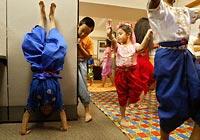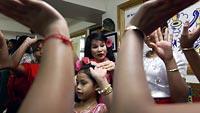 Stephan Keo, 8, left, warms up with the "monkey stretch" while Prenz Sa-Ngoun, 8, peeks around the corner to see what his friend is up to. Next to them Rosalynda Keo, 6, and others learn classical Cambodian dance — all part of a program offered through Neighborhood House, marking 100 years of service. (Photo: ALAN BERNER / THE SEATTLE TIMES)
Stephan Keo, 8, left, warms up with the "monkey stretch" while Prenz Sa-Ngoun, 8, peeks around the corner to see what his friend is up to. Next to them Rosalynda Keo, 6, and others learn classical Cambodian dance — all part of a program offered through Neighborhood House, marking 100 years of service. (Photo: ALAN BERNER / THE SEATTLE TIMES) Moly Sam, an educator with Neighborhood House, works with youngsters studying classical Cambodian dance. (Photo: ALAN BERNER / THE SEATTLE TIMES)
Moly Sam, an educator with Neighborhood House, works with youngsters studying classical Cambodian dance. (Photo: ALAN BERNER / THE SEATTLE TIMES)Friday, October 20, 2006
By Stuart Eskenazi
Seattle Times staff reporter (Washington, USA)
From a sewing circle for Jewish women who just arrived in America, to a marching band for African-American kids in the Central Area, to a dance class for Cambodian children that prepares them to be leaders among their peers, Neighborhood House has shaped its services to meet the needs of different communities at different times over the past century.
"The concept behind Neighborhood House transcends time," said Ray Li, the nonprofit's development consultant. "It's the same model of building strong communities through a sense of pride, unity and support of one another."
Neighborhood House, which operates six centers in public-housing communities in King County, celebrates its 100th anniversary tonight with a gala at McCaw Hall that will be highlighted by a performance by a professional group of classical Cambodian dancers and musicians.
A member of that group also is the teacher of the Cambodian dance class — Moly Sam, a master dancer who performed for the Cambodian royal family before coming to the U.S. in 1977. She's also an educator for another Neighborhood House program — Project HANDLE — an HIV/AIDS-prevention project that for the past three years has targeted Cambodian immigrants and their families in King County.
She teaches Cambodian parents how to be good role models and gives them tips on how to talk to their children about sex and HIV/AIDS — topics that have tended to be taboo.
Warya Pothan, Project HANDLE director, said Cambodian immigrants are considered to be at a higher risk for HIV/AIDS because of the flourishing commercial sex trade in Cambodia as well as a cultural tendency to condone excessive drinking in some social settings.
While many Neighborhood House services are straightforward — Head Start classes and transportation programs for the elderly, for example — others, such as Project HANDLE, rely on the arts and culture to engage clients more effectively.
Neighborhood House was founded in 1906 by the Council of Jewish Women as Settlement House, a center for Jews who had just arrived in Seattle from Europe.
At a building in the Central Area, immigrants took English and "Americanization" classes. By 1912, more than 140 women were enrolled in the sewing classes there.
By the 1950s, Neighborhood House had broadened its focus to all needy residents of the Central Area and Southeast Seattle. Louis Wilcox, the husband of the nonprofit's first African-American board president, started the Neighborhood House Band, a small ensemble that performed in the community.
The band drew in young people in hopes that they would throw themselves into music rather than mischief.
Five decades later, the legacy continues as Sam drills her young students in the art of Cambodian classical and folk dance, requiring them to arrive with proper dress and a proper attitude.
"I want to bring discipline — physical, mental and spiritual — into the lives of my students and let them express that through the art of dance," said Sam, who has lived in the Seattle area the past eight years.
Last Saturday morning, the girls arrived, each with her hair done up in fresh flowers and a bun. It's a dance class, but also an exercise to draw in Cambodian youth and mold them into leaders among their peers. The more mature among the dance students boast another step in their repertoire — they are peer educators for Project HANDLE.
"Dancing and teaching both take a lot of hard work and dedication," said Alex Keo, a 15-year-old Franklin High School student.
The commingling of dance and HIV/AIDS education has been good for the Cambodian community's health since the project began three years ago. So much so, in fact, that Project HANDLE just received a five-year, $2.5 million federal grant to expand its reach to East African and Vietnamese immigrants and their children.
Navy Kheav, 20, a Project HANDLE peer educator who also teaches Cambodian folk dance to her peers every Saturday morning, said that just like their parents, Cambodian youth tend to be uncomfortable talking about sex.
"When it's kept inside and not discussed within families, kids will do things they aren't supposed to do because they don't know any better — and then when they find out the facts, it's often too late," said Kheav, a University of Washington student.
"Our job as peer educators is to teach kids to be wise and make good judgments before it's too late."
Project HANDLE has trained about 135 peer educators so far, said director Pothan. At the annual Asian Water Festival in Tacoma, they performed a skit about HIV that included some graphic sexual references.
"I was afraid I'd get phone calls from people complaining," Pothan said. "But instead I had parents coming up to me and saying, 'Thank you for talking to our kids about HIV.' "
Stuart Eskenazi: 206-464-2293 or seskenazi@seattletimes.com
"The concept behind Neighborhood House transcends time," said Ray Li, the nonprofit's development consultant. "It's the same model of building strong communities through a sense of pride, unity and support of one another."
Neighborhood House, which operates six centers in public-housing communities in King County, celebrates its 100th anniversary tonight with a gala at McCaw Hall that will be highlighted by a performance by a professional group of classical Cambodian dancers and musicians.
A member of that group also is the teacher of the Cambodian dance class — Moly Sam, a master dancer who performed for the Cambodian royal family before coming to the U.S. in 1977. She's also an educator for another Neighborhood House program — Project HANDLE — an HIV/AIDS-prevention project that for the past three years has targeted Cambodian immigrants and their families in King County.
She teaches Cambodian parents how to be good role models and gives them tips on how to talk to their children about sex and HIV/AIDS — topics that have tended to be taboo.
Warya Pothan, Project HANDLE director, said Cambodian immigrants are considered to be at a higher risk for HIV/AIDS because of the flourishing commercial sex trade in Cambodia as well as a cultural tendency to condone excessive drinking in some social settings.
While many Neighborhood House services are straightforward — Head Start classes and transportation programs for the elderly, for example — others, such as Project HANDLE, rely on the arts and culture to engage clients more effectively.
Neighborhood House was founded in 1906 by the Council of Jewish Women as Settlement House, a center for Jews who had just arrived in Seattle from Europe.
At a building in the Central Area, immigrants took English and "Americanization" classes. By 1912, more than 140 women were enrolled in the sewing classes there.
By the 1950s, Neighborhood House had broadened its focus to all needy residents of the Central Area and Southeast Seattle. Louis Wilcox, the husband of the nonprofit's first African-American board president, started the Neighborhood House Band, a small ensemble that performed in the community.
The band drew in young people in hopes that they would throw themselves into music rather than mischief.
Five decades later, the legacy continues as Sam drills her young students in the art of Cambodian classical and folk dance, requiring them to arrive with proper dress and a proper attitude.
"I want to bring discipline — physical, mental and spiritual — into the lives of my students and let them express that through the art of dance," said Sam, who has lived in the Seattle area the past eight years.
Last Saturday morning, the girls arrived, each with her hair done up in fresh flowers and a bun. It's a dance class, but also an exercise to draw in Cambodian youth and mold them into leaders among their peers. The more mature among the dance students boast another step in their repertoire — they are peer educators for Project HANDLE.
"Dancing and teaching both take a lot of hard work and dedication," said Alex Keo, a 15-year-old Franklin High School student.
The commingling of dance and HIV/AIDS education has been good for the Cambodian community's health since the project began three years ago. So much so, in fact, that Project HANDLE just received a five-year, $2.5 million federal grant to expand its reach to East African and Vietnamese immigrants and their children.
Navy Kheav, 20, a Project HANDLE peer educator who also teaches Cambodian folk dance to her peers every Saturday morning, said that just like their parents, Cambodian youth tend to be uncomfortable talking about sex.
"When it's kept inside and not discussed within families, kids will do things they aren't supposed to do because they don't know any better — and then when they find out the facts, it's often too late," said Kheav, a University of Washington student.
"Our job as peer educators is to teach kids to be wise and make good judgments before it's too late."
Project HANDLE has trained about 135 peer educators so far, said director Pothan. At the annual Asian Water Festival in Tacoma, they performed a skit about HIV that included some graphic sexual references.
"I was afraid I'd get phone calls from people complaining," Pothan said. "But instead I had parents coming up to me and saying, 'Thank you for talking to our kids about HIV.' "
Stuart Eskenazi: 206-464-2293 or seskenazi@seattletimes.com

























No comments:
Post a Comment